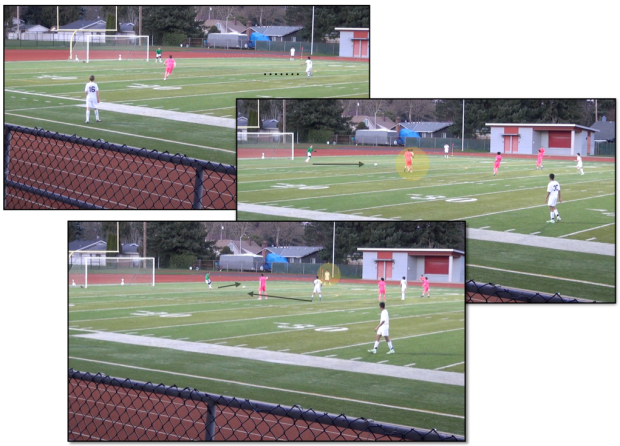Today I want to talk about my experience with implementing a set tactical strategy at the youth level. If you are purist that values individualism, and specifically individual creativity, this one probably isn’t for you.
This post is about problem solving, teamwork, strategy, and execution. And I believe these things to be critical in the development of young footballers.
EXAMPLE #1
In Spring of 2015 my 2000 boys team, then playing U14, were wrapping up league play and preparing to enter State Cup. We came up against a team that played out of the back to great success against us–the first team to do so that season. They used their goalkeeper well, and rotated their three CMs impressively. The DM would pull away from the CBs and one of the other CMs would check into the open space. Their main attacking threat was a winger that was blazing fast and a decent finisher. They would patiently move the ball around the back until they could pull us out of position and then they could find their winger and then BAM! He would do the rest.
We lost that game 4-3.
Then we were drawn into a group with that same team for State Cup. I re-watched the game film several times, as painful as it was. Their pattern of play out of the back was multi-faceted and they gave themselves a lot out possible outs, even though they were actually sloppy and were prone to poor touches and bad passes.
It wasn’t even that we didn’t press them high on their goal kicks (we did) but we were not working effectively as a unit, and kept allowing the ball to get out wide, which is where they were able to hurt us the most. Also, when we did force and error and win the ball high up, we did not punish them.
I wanted to figure out why they were able to play through us so effectively and what we could do to shut it down. So I analyzed the game.
And I noticed something.
A player under pressure always looked to play back to their keeper first. GK would play ball out to the CB, pressure came, and the ball went back to the GK. GK played up to a CM, pressure came, ball went back to the GK. And so on.
(in the following images my team is in pink, and the opposition is in white)


They had a very set pattern of play. Very predictable.
First instinct for most of us would be to just work on how we wanted to press them and go at them hard from the opening whistle. The problem with this approach is they likely get spooked early and start kicking it away. Now we are in a 50/50 situation further down the field. Not ideal.
So we could take this approach, or….
We could trap them.
We could make them think they were dictating the game (like they did for large spells the first time around), but in fact, we would be dictating the game –- without the ball!
They were likely to feel confident in their ability to build out of the back based on their success, and result, the first time around. We could use that against them.
We spent the week leading up to the game choreographing our trap and making sure everyone understood their roles. In order for our trap to work we would have to work as a unit, and not as individuals. We also worked on taking quick shots immediately upon winning the ball. Our transition to attack had to be vicious! We were going to make them cough up the ball around the top of the box, so we had to be prepared for a quick strike. We had to punish their mistakes.
The plan was to take away the wings and make them play through the middle. We were going to let them play to the areas we wanted them to play to, and use our knowledge of their tendencies against them.
THE PLAN
On goal kicks our wingers positioned themselves between the CB and the outside back. They were to stand way off the CB in order to invite the GK to play there first, but to make sure they took away the passing lane to the outside back. We could NOT to let them get the ball down the wing. Once the CB got the ball they were to apply enough pressure to get the CB to play back to the GK without overcommitting.

As this was happening our #9 would also begin to apply pressure to the CB with the ball. They took an angle which cut off a potential pass to the DM, and invited the pass back to the GK, which we knew they wanted to make anyways.
But the #9 had no interest in taking the ball from the CB.
They were just waiting for the pass back to the keeper. As soon as the CB released the back pass the #9 attacked the GK on a sprint. The #9 had freedom to take a risk here and could sell out to try and win the ball. If nothing else, his tenacity would rush the goalkeeper’s next pass/decision.


Our #10 positioned himself 8-10 yards behind the DM, just enough space to give the GK a false sense of available space for a pass up the middle. The #10 was just waiting for visual cue and then would quickly close down the DM. Our #8 and #6 manned up on the other two CMs and stayed tight on them if they dropped into space.
Nothing earth shattering here. We were just gambling on the fact that we had analyzed their play, had a game plan we were comfortable with, and they had likely not given us a second though since the last game. If we could catch them sleeping early and punish their mistakes we could jump out to an early lead and change the mentality of their play.
Game time.
Our trap worked just like we drew it up. In the opening 10 minutes we had numerous 1v1 opportunities against the goalkeeper and either hit the post or hit it straight at the keeper. We were creating the chances as expected, but we were not punishing them. This continued until half-time.
By half-time I was disappointed. I figured that they would adjust during the break and our opportunity to get a goal off of the trap was gone. We had talked all week that at some point the opponent would adjust and would likely start to break pressure with a vertical pass up field, especially since we were aggressively pressing forward and leaving some spaces in behind us.
But they didn’t adjust. They came out and continued to try the same patterns over and over again. Eventually our pressing led to a goal. Then another. Then another.
We won the game and went on to win the tournament.
***
I am not an expert of pressing traps. I am a student of the game and am constantly thinking about how I can improve my coaching, improve my teams, and help players develop.
Some would argue that using a pressing trap at the youth level is more akin to win at all costs and would maybe even consider it anti-development. I disagree.
This is football and to ignore the value, even at the youth level, does players a disservice. Let me know your thoughts below.
Have you ever used a pressing trap with your team? If so, also feel free to discuss below.













